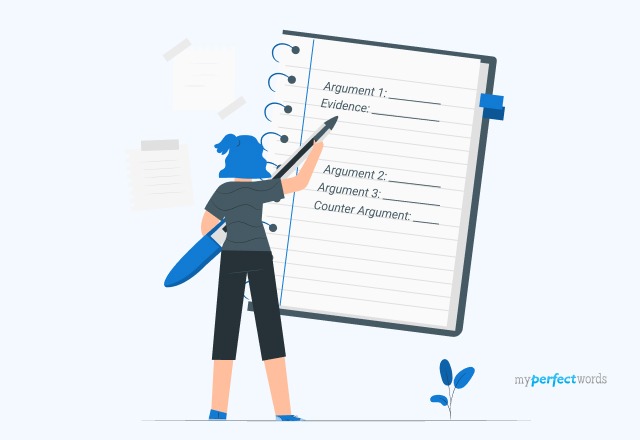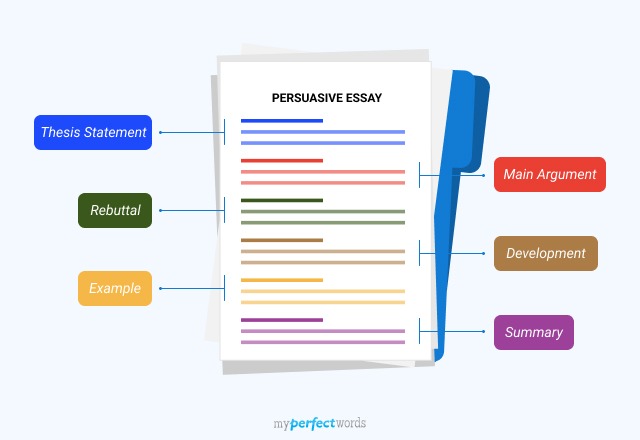What is a Persuasive Essay Outline?
When writing a persuasive essay an outline serves as a blueprint for your entire essay. It helps make sure your essay is well-organized, makes sense, and is convincing.
The main purpose of a persuasive essay is to get the reader to agree with your point of view. An outline helps you do this by organizing your thoughts, ideas, and evidence in a clear way, making it easier for your readers to understand your argument.
The main goals of a persuasive essay outline are:
- To organize your thoughts, arguments, and evidence about a topic.
- To divide your word count, paragraphs, and sections properly.
- To ensure your arguments flow logically.
Need a structured outline? Our persuasive essay writing service team delivers structured essays.
5 Steps to Create a Persuasive Essay Outline
Here's a detailed step-by-step guide to help you outline your persuasive essay:
Step 1: Choose Your Topic and Stance
Start by picking a topic that you care about and have strong feelings about. Think about what you want to convince your readers of and why it matters to you. Decide exactly where you stand on the issue.
- Are you for it or against it?
- What is the main point you want to make?
Be clear about your position, as this will guide your entire essay. Taking the time to choose a topic you are passionate about will make it easier to write and more convincing for your readers. If you need some fresh ideas, check out our 'persuasive essay topics' blog for inspiration.
Step 2: Outline the Introduction
Your introduction sets the stage for your essay. It should grab the reader's attention and give them a preview of what your essay will be about.
- Hook: Start with an engaging essay hook sentence to draw your readers in. This could be a quote, a question, a surprising fact, or a short story. The goal is to make your readers interested right from the start.
- Background Information: Give some context so your readers understand the issue. Explain why the topic is important and what the main issues are. This helps your readers see why they should care about your argument.
- Thesis Statement: Clearly state your main argument or position. This is the central point you will be making in your essay. Your thesis statement should be specific and direct, letting your readers know exactly what you will be arguing for.
Putting it all together, your introduction outline might look like this:
Topic: The Importance of Personalized Support Systems in Reducing High School Dropout Rates. Hook: Did you know that nearly 1 in 4 students drop out of high school each year due to poor academic performance? Background Information:
Thesis Statement:
|
Step 3: Plan the Body Paragraphs
The body of your essay will contain the main arguments and evidence supporting your thesis. Each paragraph should focus on one key point.
- Topic Sentence: Begin each paragraph with a sentence that states the main point of the paragraph. Your topic sentence should relate directly to your thesis.
- Evidence: Present facts, statistics, quotes, examples, or anecdotes that support your point. Make sure your evidence is credible and relevant.
- Explanation: Explain how the evidence supports your argument. This is where you connect the dots for your readers.
- Counterarguments: Address potential counterarguments to show that you have considered other perspectives. Refute these counterarguments to strengthen your own position.
- Transition: End each paragraph with a sentence that smoothly transitions to the next point. The transition words and phrases help maintain the flow of your essay.
Here is a complete example of a body paragraph outline:
|
Step 4: Develop the Conclusion
Your conclusion wraps up your essay and reinforces your main argument.
- Restate Thesis: Begin by restating your thesis in a slightly different way to remind readers of your main argument.
- Summarize Key Points: Briefly summarize the main points you made in the body paragraphs.
- Call to Action: End with a strong closing statement that encourages readers to take action or further consider your argument. This could be a suggestion, a prediction, or a call for change.
Here is how your persuasive essay conclusion outline will look like:
|
Step 5: Review and Refine
After outlining your essay, review your outline to ensure it logically flows and effectively supports your argument.
- Check Structure: Make sure each section of your outline is clearly defined and that your points follow a logical order.
- Ensure Clarity: Verify that your thesis and main points are clear and concise.
- Revise as Needed: Make any necessary adjustments to improve the clarity and effectiveness of your outline.
Watch the video below to get some tips on making outlines:
Persuasive Essay Outline Template
Here is a persuasive outline template that will help you make your essay outline. Simply fill in the blanks after identifying your main arguments and evidence.
I. Introduction a. Hook_______________________________________________________ b. Notes for context/background____________________________________ c. Thesis statement______________________________________________ II. Body Paragraph #1 a. Topic Sentence_________________________________________________ b. Supporting Evidence #1____________________________________________ c. Evidence #2__________________________________________________ d. Evidence #3_________________________________________________ e. Notes for analysis/discussion____________________________________ f. Transition___________________________________________________ III. Body Paragraph #2 a. Topic Sentence_________________________________________________ b. Supporting Evidence #1____________________________________________ c. Evidence #2__________________________________________________ d. Evidence #3_________________________________________________ e. Notes for analysis/discussion____________________________________ f. Transition___________________________________________________ IV. Body Paragraph #3 a. Topic Sentence_________________________________________________ b. Supporting Evidence #1____________________________________________ c. Evidence #2__________________________________________________ d. Evidence #3_________________________________________________ e. Notes for analysis/discussion____________________________________ f. Transition___________________________________________________ V. Conclusion a. Restate your main point__________________________________ b. Summarize your arguments________________________________ c. Concluding statement_______________________________________ |
Persuasive Essay Outline Format
The standard format follows a five-paragraph essay structure, each paragraph plays a specific role within the essay. However, the number of paragraphs can vary according to the chosen topic.
Let's break down the structure of a persuasive essay outline:
Introduction (One-Paragraph - 7-8 Sentences)
- Hook - A famous quotation, question, fact, or insight in 1-2 sentences
- Background Information about the Topic
- Thesis Statement - A strong argument in 1 sentence
Body Paragraphs (3 Paragraphs At least)
- Topic Sentence - First sentence of a paragraph that presents the main point or argument of that paragraph.
- Supporting Evidence - This can include statistics, facts, examples, anecdotes, or quotations from experts.
- Analysis/Discussion - Explaining the evidence mentioned and its relevance to the overall argument.
- Transitions - They connect a paragraph with the next paragraph to ensure a sense of flow.
Conclusion (7-8 sentences)
- Restating the Thesis - This reminds your readers of your main argument and reinforces its importance.
- Summarizing Key Points - This helps tie everything together and reinforces your argument's strength.
- Call to Action or Final Thought - Concluding sentence that aims to leave a lasting impression on your readers.
Moreover, ensure correct page formatting to ensure the readability and helpfulness of your outline. Here are some recommendations:
- Font Style: Times New Roman, Calibri, or Arial
- Font Size: 12pt
- Line Spacing: Double-spacing
- Alignment: Left-Aligned
- Margins: One-inch on all sides
- Word Count: As per instructions & requirements
Persuasive Essay Outline Examples
Below are the persuasive essay outline samples and examples to get a better idea of writing this type of essay.
Want to read complete persuasive essays about these topics? Check out our interesting persuasive essay examples.
All in all, creating a persuasive essay outline is like building a strong base for your argument. With good planning and organization, you can grab your readers' attention and convince them to see things your way. Think of your outline as a guide that keeps you on track while writing.
With the format, steps, and examples shared, you’re all set to start your persuasive writing journey.
But if you still need help writing your essay, don’t worry! MyPerfectWords.com offers a top-notch professional essay writing service to help with your academic essays. Our expert writers, with advanced qualifications and years of experience, are dedicated to delivering high-quality and original persuasive essays.
So do not wait any longer! Get our persuasive essay help today and get a well-written essay according to your specified outline format.






-9213.jpg)

-9248.jpg)


